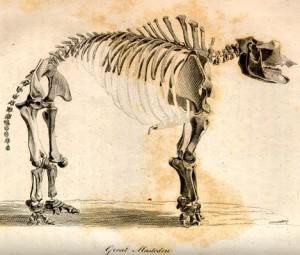 Giant mastodon skeleton from Godman’s American Natural History (1836). Skeleton of a of mastodon drawn by Titian Peale II in January of 1821. Complete mastodon skeletons were rare, and they became treasures in museums and natural history collections. The Peale museum, established in Philadelphia in 1786, was one of the first museums to place the skeleton of a mastodon on display. It is believed that the illustrations of the mastodon for Godman’s Natural History were based the Peale’s display of the skeletons in their museum.
Giant mastodon skeleton from Godman’s American Natural History (1836). Skeleton of a of mastodon drawn by Titian Peale II in January of 1821. Complete mastodon skeletons were rare, and they became treasures in museums and natural history collections. The Peale museum, established in Philadelphia in 1786, was one of the first museums to place the skeleton of a mastodon on display. It is believed that the illustrations of the mastodon for Godman’s Natural History were based the Peale’s display of the skeletons in their museum.
Mammoth and mastodon remains created excitement and confusion when they began appearing in Europe, and particularly America, during the eighteenth and early nineteenth centuries. Debate raged over whether these bones, tusks, and skulls represented existing species, fossils of extinct animals, or some other mystery of creation. Some commentators speculated that the relics came from a race of antediluvian human giants. Jefferson thought that they could not be the remains of New World elephants or hippopotami, but he believed that such creatures might still exist in North America. He argued, against Buffon and others, that New World species were not debased or lesser forms of Old World creatures. Rembrandt Peale, son to Charles Willson Peale and born in 1778, published an essay on the Spring 1801 excavation of the skeleton of a mammoth discovered in New York. In this essay, Rembrandt acknowledges the similarities between the mammoth’s skeleton and that of the elephant. He is particularly attentive to the mammoth’s great size and the greater curve and “spiral twist” of the mammoth’s tusks in comparison to the elephant. He concludes that the mammoth must have been “the first and largest of terrestrial animals” due to its immense size. In addition, according to Rembrandt, the discoveries of such skeletons and bones prove “beyond the reach of question” that such animals did at one time exist: “these great facts speak an universal language, and compel us to believe that a time has been when numbers of animals . . . larger animals than now remain, existed, had their day, and have perished; and yet the fanciful chain of nature is not broken! or else a new chain has taken place of the old.” Such discoveries contributed to a discourse of fossils and extinct species that influenced naturalists, politicians, and poets. (A.N.)
Mammoth skull (above left); mastodon legs and feet (above center and right) from Godman’s American Natural History (1836). Mammoth skulls were much larger than those of any existing African or Asian elephants, and their tusks and grinders were unlike those of any living creature. Mastodon legs and feet helped to establish evolutionary links between existing and extinct species. They also helped to explain how profoundly different the flora and fauna of the New World and Old World actually were, since for years even scientists had believed that a single act of creation must have resulted in similar animals around the globe. Now it became obvious that different parts of the world were home to widely, and often wildly, different creatures. There had to be a different explanation as to where they–and we–had come from originally.



